Related Research Articles
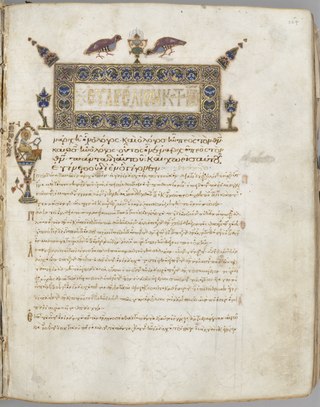
An illuminated manuscript is a formally prepared document where the text is decorated with flourishes such as borders and miniature illustrations. Often used in the Roman Catholic Church for prayers and liturgical books such as psalters and courtly literature, the practice continued into secular texts from the 13th century onward and typically include proclamations, enrolled bills, laws, charters, inventories, and deeds.

The Cathach of St. Columba, known as the Cathach, is a late 6th century Insular psalter. It is the oldest surviving manuscript in Ireland, and the second oldest Latin psalter in the world.

A miniature is a small illustration used to decorate an ancient or medieval illuminated manuscript; the simple illustrations of the early codices having been miniated or delineated with that pigment. The generally small scale of such medieval pictures has led to etymological confusion with minuteness and to its application to small paintings, especially portrait miniatures, which did however grow from the same tradition and at least initially used similar techniques.

The Echternach Gospels were produced, presumably, at Lindisfarne Abbey in Northumbria around the year 690. This location was very significant for the production of Insular manuscripts, such as the Durham Gospels and the Lindisfarne Gospels. The scribe of the Durham Gospels is believed to have created the Echternach Gospels as well. The Echternach Gospels are now in the collection of France's Bibliothèque Nationale in Paris.

Western calligraphy is the art of writing and penmanship as practiced in the Western world, especially using the Latin alphabet.

The Vespasian Psalter is an Anglo-Saxon illuminated psalter decorated in a partly Insular style produced in the second or third quarter of the 8th century. It contains an interlinear gloss in Old English which is the oldest extant English translation of any portion of the Bible. It was produced in southern England, perhaps in St. Augustine's Abbey or Christ Church, Canterbury or Minster-in-Thanet, and is the earliest illuminated manuscript produced in "Southumbria" to survive.

The Benedictional of St Æthelwold is a 10th-century illuminated benedictional, the most important surviving work of the Anglo-Saxon Winchester School of illumination. It contains the various pontifical blessings used during Mass on the differing days of the ecclesiastical year, along with a form for blessing the candles used during the Feast of the Purification. The manuscript was written by the monk Godeman at the request of Æthelwold, Bishop of Winchester.

Ottonian art is a style in pre-romanesque German art, covering also some works from the Low Countries, northern Italy and eastern France. It was named by the art historian Hubert Janitschek after the Ottonian dynasty which ruled Germany and Northern Italy between 919 and 1024 under the kings Henry I, Otto I, Otto II, Otto III and Henry II. With Ottonian architecture, it is a key component of the Ottonian Renaissance. However, the style neither began nor ended to neatly coincide with the rule of the dynasty. It emerged some decades into their rule and persisted past the Ottonian emperors into the reigns of the early Salian dynasty, which lacks an artistic "style label" of its own. In the traditional scheme of art history, Ottonian art follows Carolingian art and precedes Romanesque art, though the transitions at both ends of the period are gradual rather than sudden. Like the former and unlike the latter, it was very largely a style restricted to a few of the small cities of the period, and important monasteries, as well as the court circles of the emperor and his leading vassals.
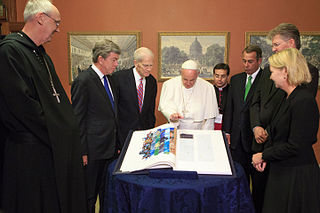
The Saint John's Bible is the first completely handwritten and illuminated Bible to be commissioned by a Benedictine abbey since the invention of the printing press. The project was headed by Donald Jackson, and work on the manuscript took place in both Wales and Minnesota. Work on the 1,100 page Bible began in 1998 when it was commissioned by the Benedictine monks at Saint John's University, and was completely finished in December 2011 at a total cost of over $8 million. The Saint John's Bible is divided into seven volumes and is two feet tall by three feet wide when open. The book is written on vellum by quill, containing 160 illuminations across its seven volumes, and uses the New Revised Standard Version Catholic Edition (NRSV-CE) of the Bible. A copy of The Saint John's Bible has been presented to the Pope at the Vatican in several volumes, with the final volume presented on April 17, 2015.
A limner is an illuminator of manuscripts, or more generally, a painter of ornamental decoration. One of the earliest mentions of a limner's work is found in the book Methods and Materials of Painting by Charles Lock Eastlake (1793–1865).
"The treatises [on oil painting] cannot be placed later than the thirteenth, or beginning of the fourteenth, century. This was the age of Dante, and "the art which in Paris was called illuminating" (limning) is well illustrated by such guides." p. 45
The conservation and restoration of illuminated manuscripts is the care and treatment of illuminated manuscripts which have cultural and historical significance so that they may be viewed, read, and studied now and in the future. It is a specialty case of the conservation and restoration of parchment within the field of conservation and restoration of books, manuscripts, documents and ephemera.

The Sherborne Missal is an early 15th-century English illuminated manuscript missal, one of the finest English examples of International Gothic painting. With 347 vellum leaves measuring 535 by 380 millimetres, it weighs 20 kg. It has survived in excellent condition, and is usually on display at the Ritblat Gallery in the British Library. It has been described as "beyond question the most spectacular service book of English execution to have come down to us from the later Middle Ages."
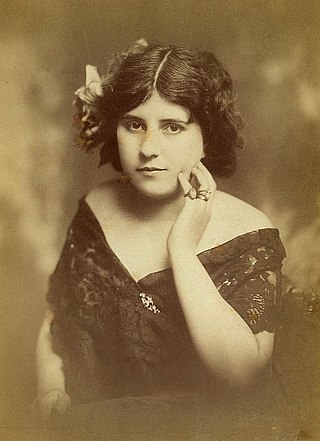
Adelina de Lara OBE was a British classical pianist and composer.
Janet Moira Backhouse was an English manuscripts curator at the British Museum, and a leading authority in the field of illuminated manuscripts.
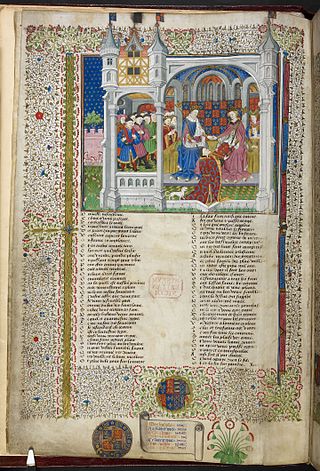
The Royal manuscripts are one of the "closed collections" of the British Library, consisting of some 2,000 manuscripts collected by the sovereigns of England in the "Old Royal Library" and given to the British Museum by George II in 1757. They are still catalogued with call numbers using the prefix "Royal" in the style "Royal MS 2. B. V". As a collection, the Royal manuscripts date back to Edward IV, though many earlier manuscripts were added to the collection before it was donated. Though the collection was therefore formed entirely after the invention of printing, luxury illuminated manuscripts continued to be commissioned by royalty in England as elsewhere until well into the 16th century. The collection was expanded under Henry VIII by confiscations in the Dissolution of the Monasteries and after the falls of Henry's ministers Cardinal Wolsey and Thomas Cromwell. Many older manuscripts were presented to monarchs as gifts; perhaps the most important manuscript in the collection, the Codex Alexandrinus, was presented to Charles I in recognition of the diplomatic efforts of his father James I to help the Eastern Orthodox churches under the rule of the Ottoman Empire. The date and means of entry into the collection can only be guessed at in many if not most cases. Now the collection is closed in the sense that no new items have been added to it since it was donated to the nation.

Kidskin or kid leather is a type of soft, thin leather that is traditionally used for gloves. It is widely used for other fashion purposes such as footwear and clothing. Kidskin is traditionally made from goatskin - more specifically, the skin of young goats, although equivalent leathers such as lambskin and chickenskin give the same effect.
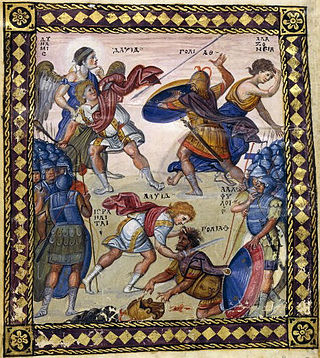
Byzantine illuminated manuscripts were produced across the Byzantine Empire, some in monasteries but others in imperial or commercial workshops. Religious images or icons were made in Byzantine art in many different media: mosaics, paintings, small statues and illuminated manuscripts. Monasteries produced many of the illuminated manuscripts devoted to religious works using the illustrations to highlight specific parts of text, a saints' martyrdom for example, while others were used for devotional purposes similar to icons. These religious manuscripts were most commissioned by patrons and were used for private worship but also gifted to churches to be used in services.
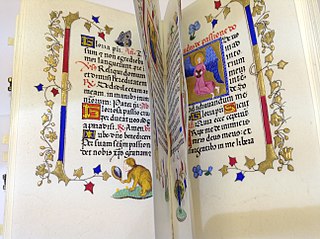
Patricia Lovett is a British scribe, calligrapher and illuminator from Kent. She is the author of several books and teaches calligraphy, illumination and manuscript skills in the UK and worldwide. She was chair of the Heritage Crafts Association between 2017 and 2022, having been vice-chair for several years previously and in 2013 was awarded an MBE for services to calligraphy and the protection of heritage crafts.
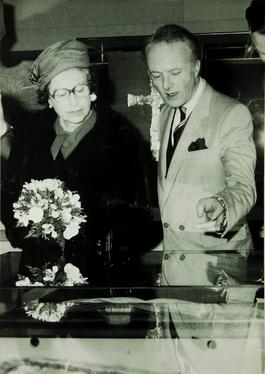
Derek Howard Turner was an English museum curator and art historian who specialised in liturgical studies and illuminated manuscripts. He worked at the British Museum and the British Library from 1956 until his death, focusing on exhibitions, scholarship, and loans.
References
- 1 2 3 4 Rubinstein, William L.; Jolles, Michael; Rubinstein, Hilary, eds. (27 January 2011). "Laurent de Lara, David". The Palgrave Dictionary of Anglo-Jewish History. ISBN 9780230318946.
- 1 2 3 de Lara, Adelina; Abrahall, Clare H. (1955). Finale. Burke. p. ii.
- 1 2 3 4 5 6 7 Watson, Rowan (2007). "Publishing for the Leisure Industry". In Coomans D, Thomas; De Maeyer, Jan (eds.). The revival of medieval illumination : nineteenth-century Belgium manuscripts and illuminations from a european perspective = Renaissance de l'enluminure médiévale : manuscripts et enluminures belges du XIXe siècle et leur contexte européen. Leuven: KADOC. pp. 88–92. ISBN 9789058675910.
- 1 2 3 4 Beckwith, Alice H. R. H. "Frontispiece and title-page from "Elementary Instruction on the Art of Illumination" by David Laurent de Lara (active 1850s & '60s)". The Victorian Web. Retrieved 16 May 2017.
- 1 2 Brooks, J. Willis; De la Motte, Freeman Gage (1864). "Introduction". Medieval Alphabets and Initials for Illuminators. London: C. Lockwood & Co.
- ↑ "Article cited by Watson". Art Journal: 223. 1859.
- ↑ "Article cited by Watson". The Athenaeum: 684. 21 May 1859.
- ↑ "Article cited by Watson". Art Journal: 320. 1860.
- ↑ Laurent de Lara, David (1850). Elementary Instruction on the Art of Illumination and Missal Painting on Vellum: with Illustrations for Copying for the Student. London: Ackermann & Co. p. 6.
- ↑ NB: Palgrave spells Sarah's surname Crawcour.
Further reading
- Beckwith, Alice H. R. H.; Art, Rhode Island School of Design Museum of. Victorian bibliomania: the illuminated book in 19th-century Britain. Museum of Art, Rhode Island School of Design.